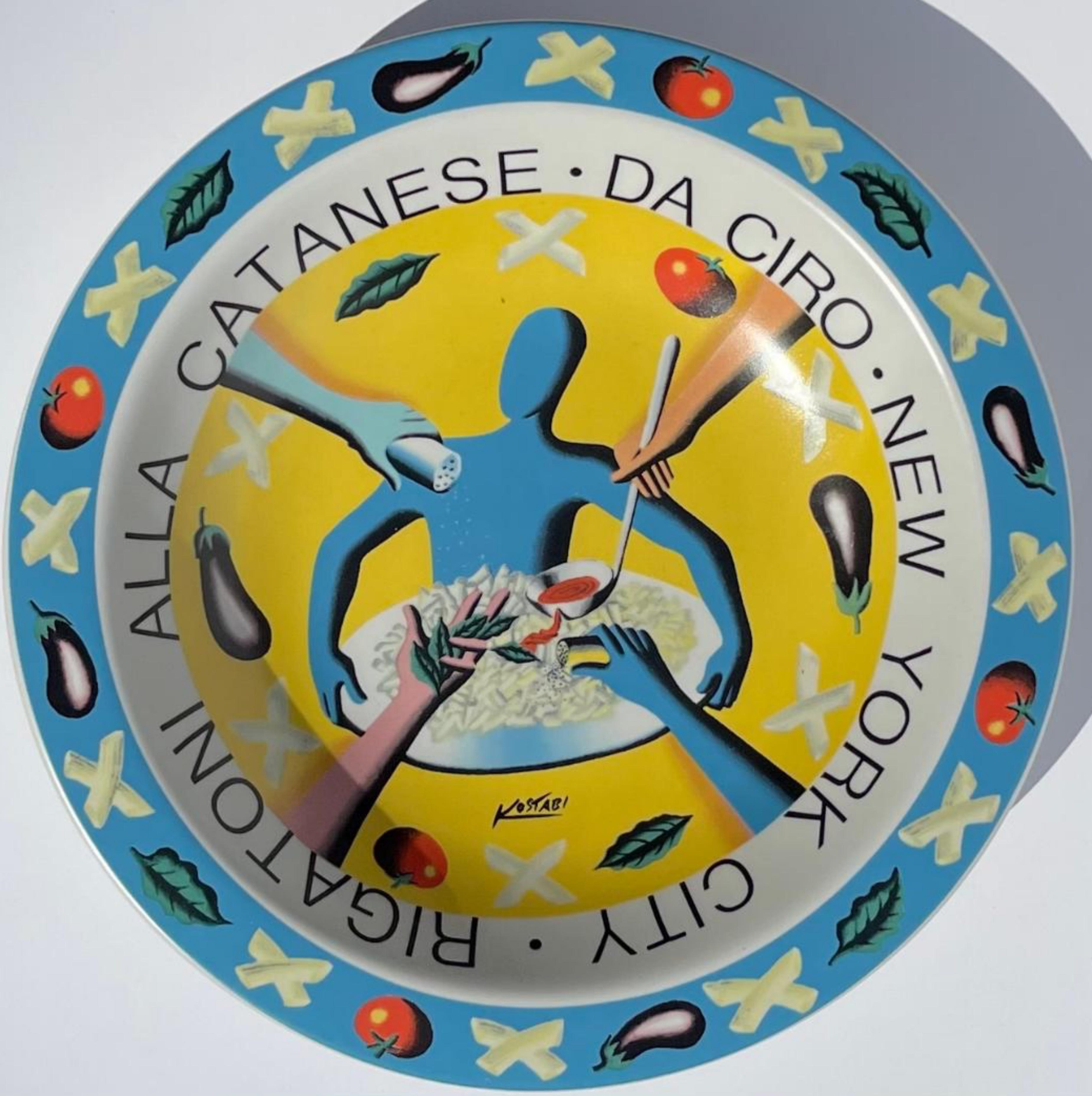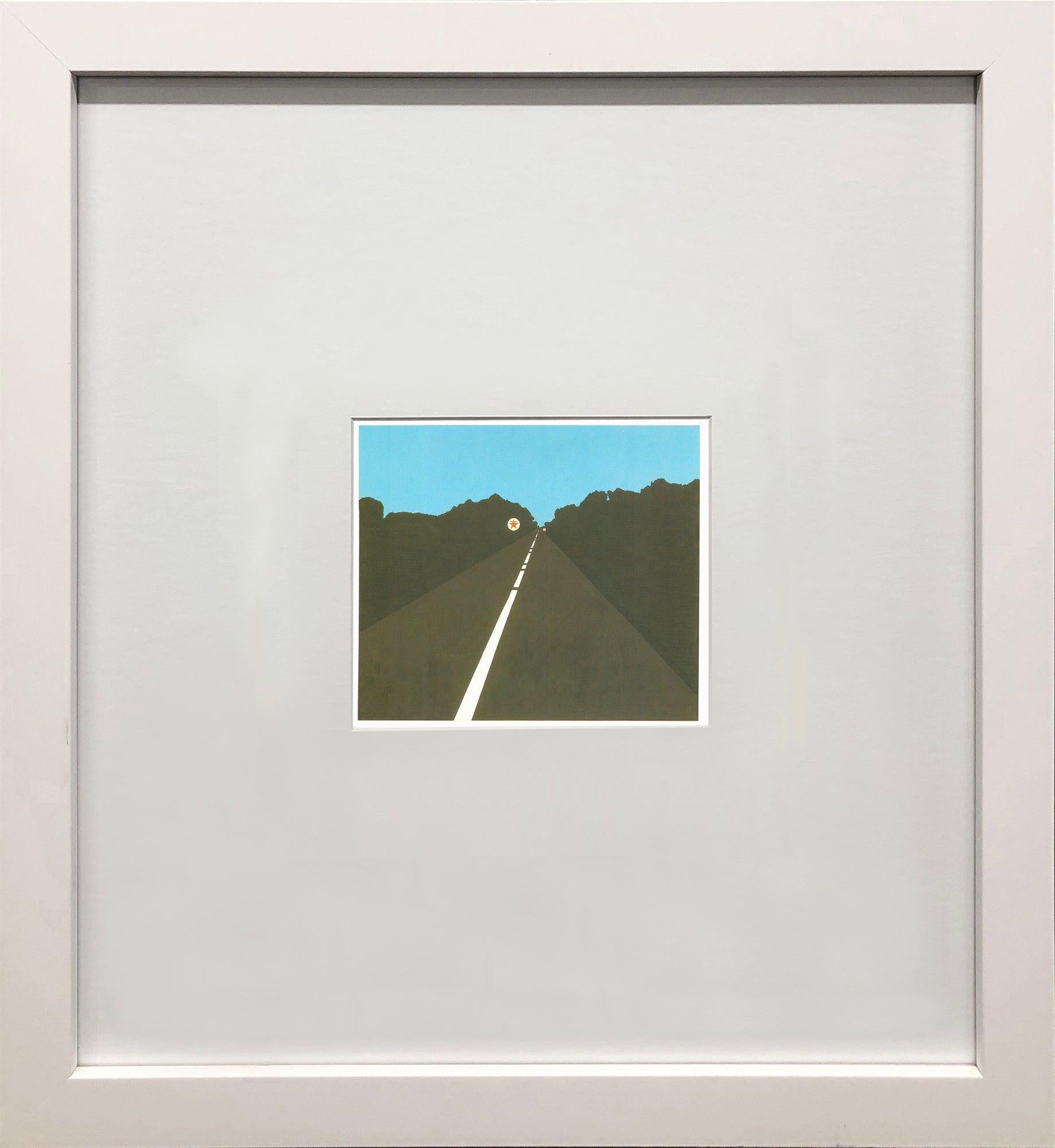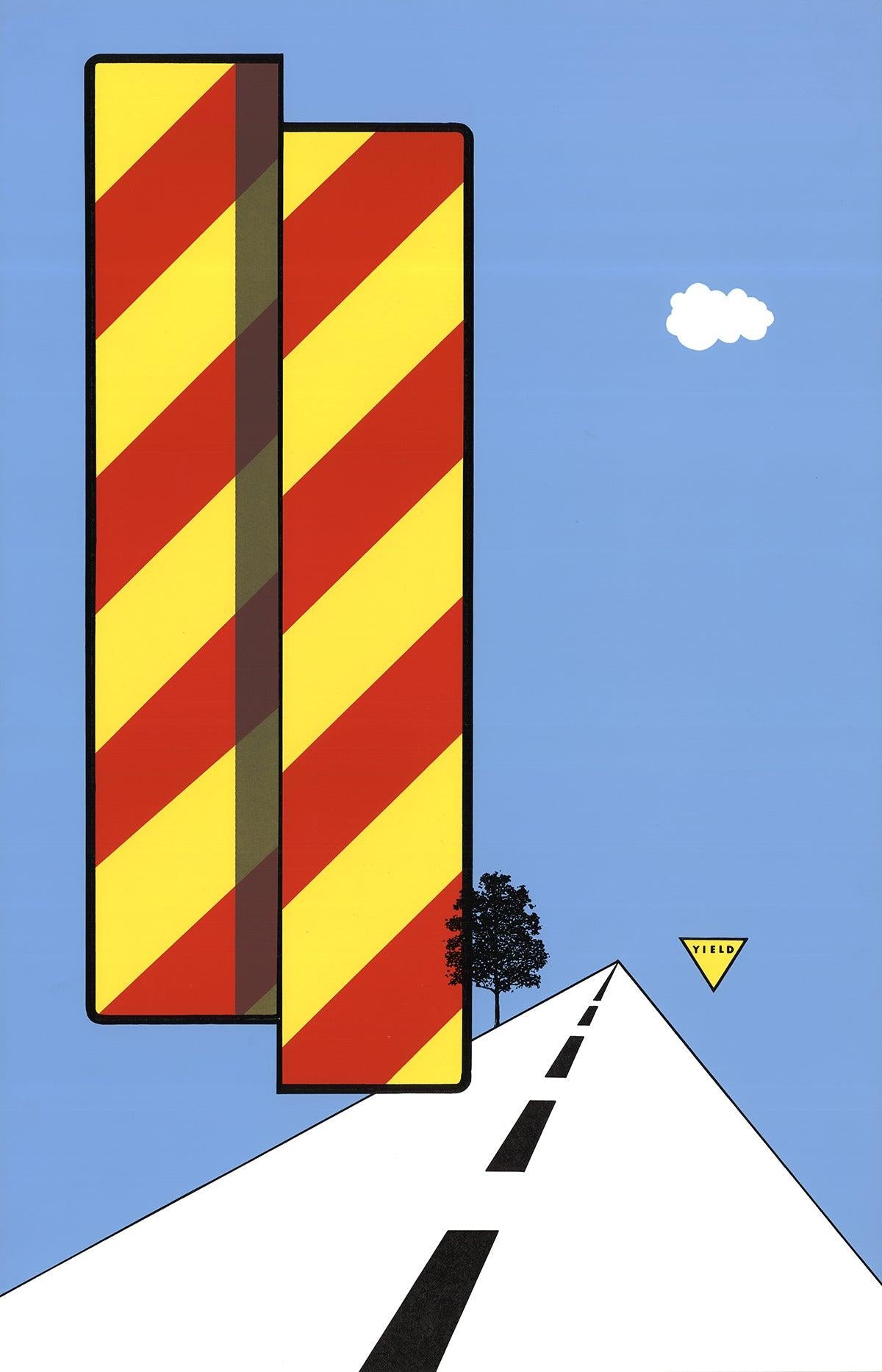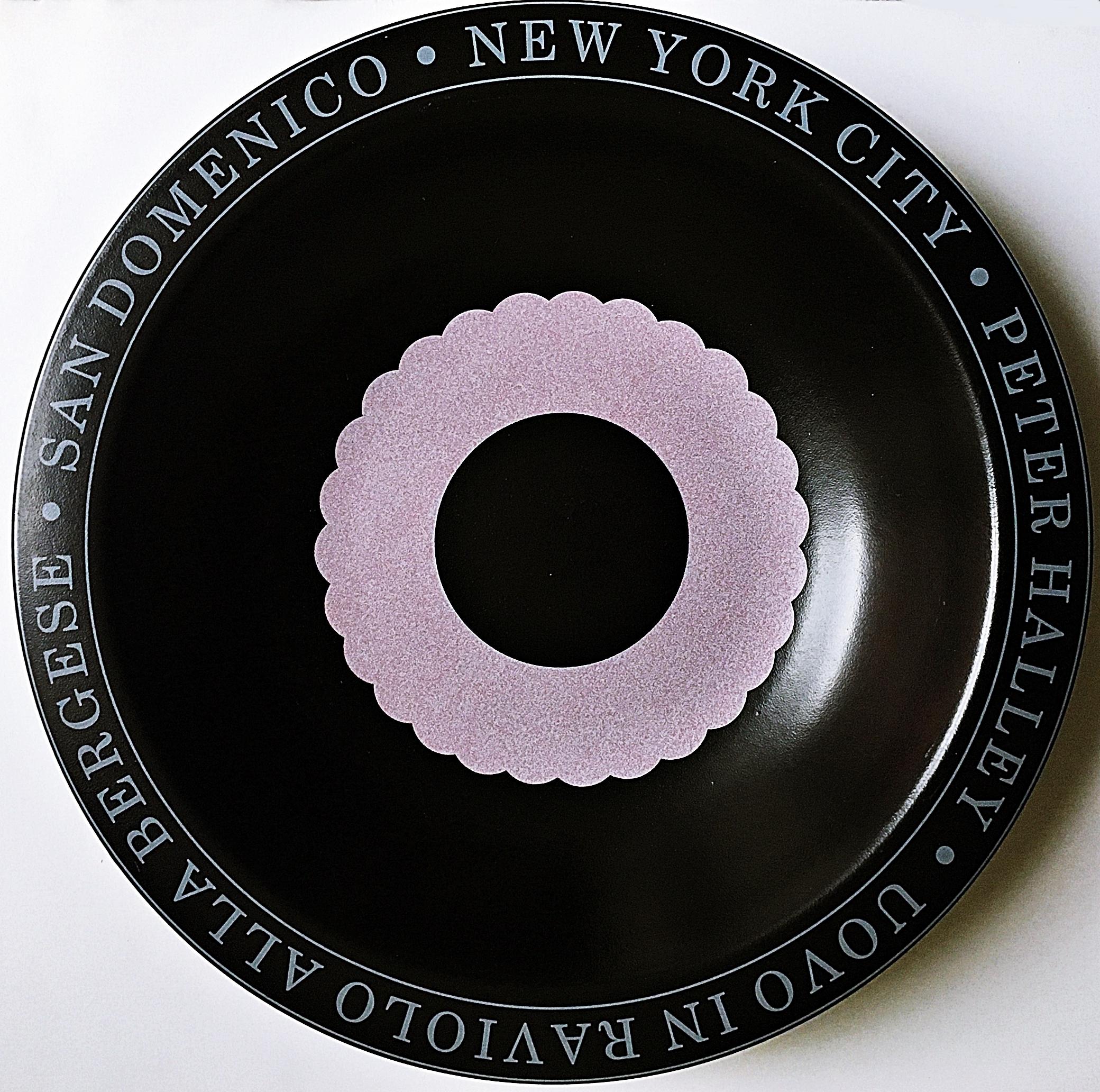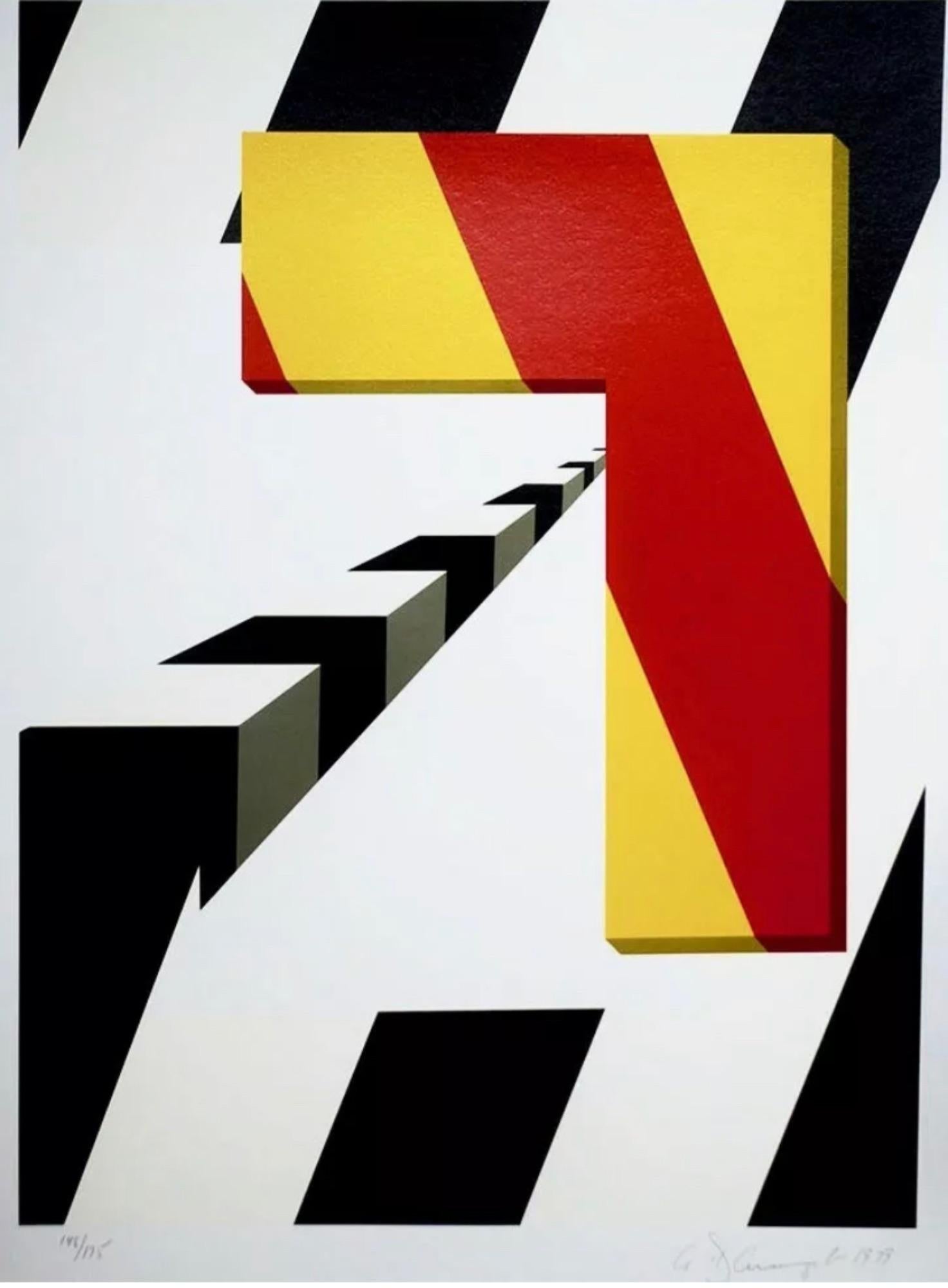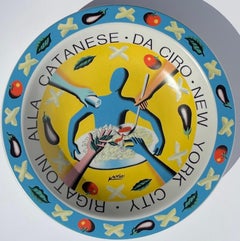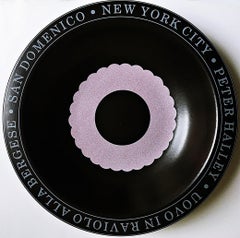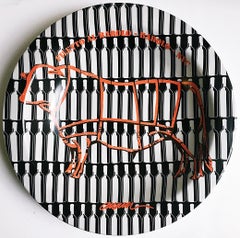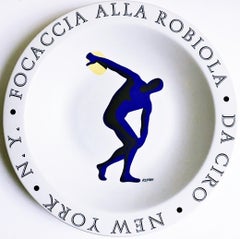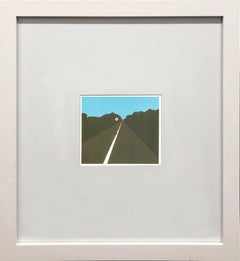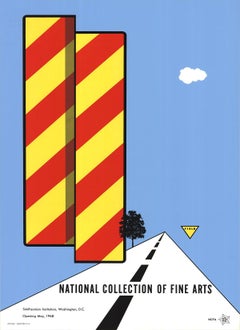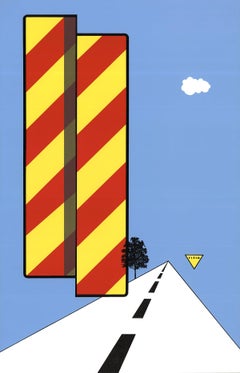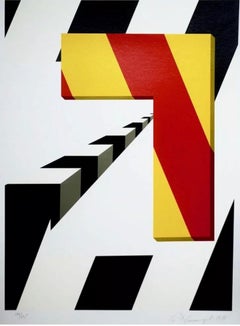Items Similar to Trenette Al Pesto - I Tre Merli - New York, NY
Want more images or videos?
Request additional images or videos from the seller
1 of 5
Allan D'ArcangeloTrenette Al Pesto - I Tre Merli - New York, NY1998
1998
$1,500
£1,164.28
€1,326.51
CA$2,143.66
A$2,334.61
CHF 1,230.96
MX$28,395.60
NOK 15,479.25
SEK 14,518.27
DKK 9,905.44
About the Item
Allan D'Arcangelo
Trenette Al Pesto - I Tre Merli - New York, NY, 1998
Ceramic Plate
Artist signature fired into the plate on the back and numbered 132 from the edition of 1000.
10 1/8 inch diameter by 1/4 inch height
Unframed
"My most profound experiences of landscape were looking through the windshield." - Allan D'Arcangelo.
Note: the stated edition is 1000, but far fewer were actually made, and many were said to have been lost after 9/11 which is why this is so scarce.
Makes a memorable and very special gift! This beautiful, extremely rare limited edition, signed and numbered bowl/plate was handmade in southern Italy by master artisans near Vietri sul Mare. It was designed by renowned American painter Allan D'Arcangelo. From the late 1990s through the millenium, Buon Ricordo America, Inc. commissioned famous artists, including D'Arcangelo to design plates for their flagship restaurants as special one-time only charitable fundraiser. D'Arcangelo designed the present work for the renowned NY Italian restaurant - I Tre Merli. D'Arcangelo's design depicts one of the restaurant's signature dishes, Trenette Al Pesto. This plate is a real collector's item -- and difficult to find -- it was created in a limited edition of only 1000 and never mass marketed. The artist's signature is fired into the plate on the back and numbered from the limited edition of 1000. In the early 2000s, Buon Ricordo America, Inc. collaborated with some of America's most prominent artists - including D'Arcangelo - to make a series of plates for iconic restaurants throughout the United States. The project ended after the September 11th terrorist attacks, which affected many of the restaurants in Manhattan.
These plates were made in conjunction with Buon Ricordo America, Inc., an offshoot of the Italian restaurant union, Boun Ricordo (Unione Ristoranti del Buon Ricordo). The plates capture the essence of each restaurant’s local specialty, and the decoration is embellished with references to the restaurant, its local territory and products. The rim of each plate bears the name of the restaurant and the town or village it is in. This plate was made from local clay from a quarry in Ogliara, a few kilometres from Vietri. After biscuit firing they are coated and decorated by hand by skilled craftsmen using a carbon “dusting” technique similar to that once used for Renaissance fresco painting. Once the plates were decorated they are glazed and fired for a second time to fix their vivid colors.
The back of the plate reads as follows:
"Limited edition designed by the artist to benefit charitable organizations dedicated feeding needy homebound elderly persons and helping children at risk from abuse and disease."
"The artist does not derive any income from the sale of this plate."
"Microwave, oven and dishwasher safe."
About the Seller
5.0
Platinum Seller
Premium sellers with a 4.7+ rating and 24-hour response times
Established in 2007
1stDibs seller since 2022
458 sales on 1stDibs
Typical response time: 2 hours
- ShippingRetrieving quote...Shipping from: New York, NY
- Return Policy
Authenticity Guarantee
In the unlikely event there’s an issue with an item’s authenticity, contact us within 1 year for a full refund. DetailsMoney-Back Guarantee
If your item is not as described, is damaged in transit, or does not arrive, contact us within 7 days for a full refund. Details24-Hour Cancellation
You have a 24-hour grace period in which to reconsider your purchase, with no questions asked.Vetted Professional Sellers
Our world-class sellers must adhere to strict standards for service and quality, maintaining the integrity of our listings.Price-Match Guarantee
If you find that a seller listed the same item for a lower price elsewhere, we’ll match it.Trusted Global Delivery
Our best-in-class carrier network provides specialized shipping options worldwide, including custom delivery.More From This Seller
View AllLimited Edition Ceramic Plate Rigatoni Alla Catanese - Da Ciro - New York, NY
By Mark Kostabi
Located in New York, NY
Mark Kostabi
Plate for Rigatoni Alla Catanese - Da Ciro - New York, NY, 2001
Silkscreen on ceramic plate; Microwave and Dishwasher Safe
10 1/5 in diameter
Artist signature fired into the plate on the underside and numbered from an edition of 510.
Edition 36/510
Makes a wonderful gift! This beautiful, whimsical limited edition, signed and numbered bowl/plate was handmade in southern Italy by master artisans near Vietri sul Mare, was designed by American artist Mark Kostabi. In 2000, Buon Ricordo America, Inc. commissioned famous American artists to design plates for their flagship US restaurants. In 2000-1, Kostabi designed the present work for the NY Italian restaurant...
Category
Early 2000s Pop Art Mixed Media
Materials
Ceramic, Screen
Limited Edition ceramic plate Uovo In Raviolo Alla Bergese, San Domenico NY S/N
By Peter Halley
Located in New York, NY
Peter Halley
Uovo In Raviolo Alla Bergese - San Domenico - New York, NY, ca. 2000
Limited Edition Ceramic Plate.
Artist signature fired into the plate on the underside and numbered 166 from the edition of 510.
10 3/10 inches diameter by 1/4 inch height
Makes a terrific gift. This beautiful, limited edition, extremely rare, plate signed and numbered bowl/plate was handmade in southern Italy by master artisans near Vietri sul Mare. The edition is 510 - but the reason one rarely sees this on the market is because only about half that amount were said to have been created, and the remaining ones were lost after 9/11; the plan was to create a second batch after these sold out. That was in the year 2000. Then in 2001 terrorists struck the World Trade Center. All marketing efforts ceased. It is not even known if the other plates from this edition are still around - but they are rarely found on the marketplace. It was designed by the internationally renowned American artist Peter Halley. In 2000, Buon Ricordo...
Category
Early 2000s Contemporary Mixed Media
Materials
Ceramic, Screen, Mixed Media
Arman: Filetto Al Barolo - Barolo - New York, NY, Limited edition Artist Plate
By Arman
Located in New York, NY
Arman
Filetto Al Barolo - Barolo - New York, NY, 1998
Ceramic Plate
Signed in plate, Artist signature fired into the plate on the front and back and numbered 157 from the edition of 1000. (far fewer made)
10 3/10 inches diameter by 1/4 inches height
Unframed
Very rare as only a fraction were actually made, and many were thought to have been lost after 9/11. Makes a memorable and very special gift! This beautiful, extremely rare limited edition, signed and numbered bowl...
Category
1990s Abstract Mixed Media
Materials
Ceramic, Screen, Porcelain
Focaccia Alla Robiola - Da Ciro - New York, NY
By Mark Kostabi
Located in New York, NY
Mark Kostabi
Focaccia Alla Robiola - Da Ciro - New York, NY, 1998
Ceramic Plate.
Artist signature fired into the plate on the front and back and numbered 59 of 1000.
10 1/5 inch diameter x 1/4 inch height
Unframed
Makes a memorable and very special gift! This beautiful, limited edition, signed and numbered bowl...
Category
1990s Contemporary Mixed Media
Materials
Ceramic, Screen
Constellation, Dazzling unique signed geometric abstraction painting, 1970s art
Located in New York, NY
Allan D'Arcangelo
Constellation, 1971
Acrylic on paper, mounted to canvas
Hand signed and dated 1971 lower front
Frame included
Measurements:
Framed:
23.75 x 23.75 x 1.25 inches
Artw...
Category
1970s Pop Art Abstract Paintings
Materials
Canvas, Acrylic, Laid Paper, Permanent Marker
Richard Pettibone The Appropriation Warhol, Stella, Lichtenstein, Unique Signed
By Richard Pettibone
Located in New York, NY
Richard Pettibone
The Appropriation Print Andy Warhol, Frank Stella, Roy Lichtenstein, 1970
Silkscreen in colors on masonite board (unique variant on sculpted board)
Hand-signed by artist, Signed and dated on the front (see close up image)
Bespoke frame Included
This example of Pettibone's iconic Appropriation Print is silkscreened on masonite board rather than paper, giving it a different background hue, and enabling it work to be framed so uniquely.
The Appropriation print is one of the most coveted prints Pettibone ever created ; the regular edition is on a full sheet with white background; the present example was silkscreened on board, allowing it to be framed in 3-D. While we do not know how many examples of this graphic work Pettibone created, so far the present work is the only one example we have ever seen on the public market since 1970. (Other editions of The Appropriation Print have been printed on vellum, wove paper and pink and yellow paper.)
This 1970 homage to Andy Warhol, Frank Stella and Roy Lichtenstein exemplifies the type of artistic appropriation he was engaging in early on during the height of the Pop Art movement - long before more contemporary artists like Deborah Kass, Louise Lawler, etc. followed suit.
This silkscreen was in its original 1970 vintage period frame; a bespoke custom hand cut black wood outer frame was subsequently created especially to house the work, giving it a distinctive sculptural aesthetic.
Measurements:
Framed 14.5 inches vertical by 18 inches horizontal by 2 inches
Work
13 inches vertical by 16.5 inches horizontal
Richard Pettibone biography:
Richard Pettibone (American, b.1938) is one of the pioneering artists to use appropriation techniques. Pettibone was born in Los Angeles, and first worked with shadow boxes and assemblages, illustrating his interest in craft, construction, and working in miniature scales. In 1964, he created the first of his appropriated pieces, two tiny painted “replicas” of the iconic Campbell’s soup cans by Andy Warhol (American, 1928–1987). By 1965, he had created several “replicas” of paintings by American artists, such as Warhol, Roy Lichtenstein (1923–1997), Ed Ruscha (b.1937), and others, among them some of the biggest names in Pop Art. Pettibone chose to recreate the work of leading avant-garde artists whose careers were often centered on themes of replication themselves, further lending irony to his work. Pettibone also created both miniature and life-sized sculptural works, including an exact copy of Bicycle Wheel by Marcel Duchamp (French, 1887–1968), and in the 1980s, an entire series of sculptures of varying sizes replicating the most famous works of Constantin Brancusi (Romanian, 1876–1957). In more recent years, Pettibone has created paintings based on the covers of poetry books by Ezra Pound, as well as sculptures drawn from the grid compositions of Piet Mondrian (Dutch, 1872–1944). Pettibone straddles the lines of appropriation, Pop, and Conceptual Art, and has received critical attention for decades for the important questions his work raises about authorship, craftsmanship, and the original in art. His work has been exhibited at the Institute for Contemporary Art in Philadelphia, the Museum of Modern Art in New York, the Museum of Contemporary Art in Miami, and the Laguna Art Museum in Laguna Beach, CA. Pettibone is currently based in New York.
"I wished I had stuck with the idea of just painting the same
painting like the soup can and never painting another painting.
When someone wanted one, you would just do another one.
Does anybody do that now?"
Andy Warhol, 1981
Since the mid-1960s, Richard Pettibone has been making
hand-painted, small-scale copies of works by other artists — a
practice due to which he is best known as a precursor of appropriation art — and for a decade now, he has been revisiting subjects from across his career. In his latest exhibitions at
Castelli Gallery, Pettibone has been showing more of the “same”
paintings that had already been part of his 2005–6 museum retrospective,1
and also including “new” subject matter drawn from
his usual roster of European modernists and American postwar
artists. Art critic Kim Levin laid out some phases of the intricate spectrum from copies to repetitions in her review of the
Warhol-de Chirico showdown, a joint exhibition at the heyday
of appropriation art in the mid-1980s when Warhol’s appropriations of de Chirico’s work effectively revaluated “the grand
old auto-appropriator”.
Upon having counted well over a dozen
Disquieting Muses by de Chirico, Levin speculated: “Maybe he
kept doing them because no one got the point. Maybe he needed the money. Maybe he meant it when he said his technique
had improved, and traditional skills were what mattered.”
On
the other side, Warhol, in her eyes, was the “latter-day exemplar
of museless creativity”.
To Pettibone, traditional skills certainly
still matter, as he practices his contemporary version of museless creativity. He paints the same painting again and again,
no matter whether anybody shows an interest in it or not. His
work, of course, takes place well outside the historical framework of what Levin aptly referred to as the “modern/postmodern wrestling match”,
but neither was this exactly his match
to begin with.
Pettibone is one of appropriation art’s trailblazers, but his diverse
selection of sources removes from his work the critique of the
modernist myth of originality most commonly associated with
appropriation art in a narrow sense, as we see, for example, in
Sherrie Levine’s practice of re-photographing the work of Walker
Evans and Edward Weston. In particular, during his photorealist
phase of the 1970s, Pettibone’s sources ranged widely across
several art-historical periods. His appropriations of the 1980s
and 1990s spanned from Picasso etchings and Brancusi sculptures to Shaker furniture and even included Ezra Pound’s poetry.
Pettibone has professed outright admiration for his source artists, whose work he shrinks and tweaks to comic effect but, nevertheless, always treats with reverence and care. His response
to these artists is primarily on an aesthetic level, owing much
to the fact that his process relies on photographs. By the same
token, the aesthetic that attracts him is a graphic one that lends
itself to reproduction. Painstakingly copying other artists’ work by hand has been a way of making
it his own, yet each source is acknowledged in
his titles and, occasionally, in captions on white
margins that he leaves around the image as an
indication that the actual source is a photographic image. The enjoyment he receives in copying
is part of the motivation behind doing it, as is
the pleasure he receives from actually being with
the finished painting — a considerable private
dimension of his work. His copies are “handmade
readymades” that he meticulously paints in great quantities in his studio upstate in New York; the commitment
to manual labor and the time spent at material production has
become an increasingly important dimension of his recent work.
Pettibone operates at some remove from the contemporary art
scene, not only by staying put geographically, but also by refusing to recoup the simulated lack of originality through the
creation of a public persona.
In so doing, Pettibone takes a real
risk. He places himself in opposition to conceptualism, and he is
apprehensive of an understanding of art as the mere illustration
of an idea. His reading of Marcel Duchamp’s works as beautiful
is revealing about Pettibone’s priorities in this respect.
When
Pettibone, for aesthetic pleasure, paints Duchamp’s Poster for
the Third French Chess...
Category
1970s Pop Art Abstract Prints
Materials
Masonite, Pencil, Screen
You May Also Like
Allan D'Arcangelo 'Highway U.S. 1, Number 5' 1992
By Allan D'Arcangelo 1
Located in Brooklyn, NY
Highway U.S. 1, Number 5 by Allan D’Arcangelo is an offset lithograph from a portfolio of six prints published by the Museum of Modern Art, now long out of print and sought after by ...
Category
1990s Pop Art Prints and Multiples
Materials
Offset
1968 After Allan D'Arcangelo 'Yield' FIRST EDITION Pop Art
By Allan D'Arcangelo 1
Located in Brooklyn, NY
First edition exhibition poster by Alan D’Arcangelo, created for his exhibition at the Smithsonian Institution, Washington, D.C. Published by List Art and printed in serigraph by HKL...
Category
1960s Pop Art Prints and Multiples
Materials
Screen
Yield
By Allan D'Arcangelo 1
Located in Brooklyn, NY
"Yield" by Allan D’Arcangelo uses the familiar road sign as a symbol of caution and submission, reflecting themes of modern life, societal control, and decision-making. The yield sig...
Category
1960s Pop Art Figurative Prints
Materials
ABS, Screen
$320 Sale Price
20% Off
Left Turn, Allan D'Arcangelo
By Allan D'Arcangelo 1
Located in Fairfield, CT
Artist: Allan D’Arcangelo (1930-1998)
Title: Left Turn
Year: 1979
Edition: 148/175, plus proofs
Medium: Silkscreen on Arches paper
Size: 34 x 26 inches
Condition: Excellent
Inscripti...
Category
1970s Pop Art Abstract Prints
Materials
Screen
$1,036 Sale Price
20% Off
June, Pop Art Print by D'arcangelo 1969
By Allan D'Arcangelo 1
Located in Long Island City, NY
Artist: Allan D'Arcangelo, American (1930 - 1998)
Title: June
Year: 1969
Medium: Silkscreen, signed and numbered in pencil
Edition: 6/100
Size: 14 x 12 in. (35.56 x 30.48 cm)
Frame: ...
Category
1960s Pop Art Abstract Prints
Materials
Screen
Yield from Homage to Picasso, Geometric Abstract Screenprint by D'Arcangelo
By Allan D'Arcangelo 1
Located in Long Island City, NY
Artist: Allan D'Arcangelo
Title: Yield from Homage to Picasso
Year: 1973
Medium: Screenprint, Signed and Numbered in Pencil
Edition: 4/90
Size: 30 x 22 inches
Category
1970s Pop Art Abstract Prints
Materials
Screen
